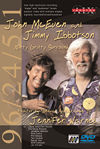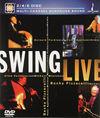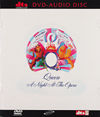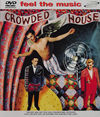Come Together
DVD is a hit. Lauded as the most successful format launch since—well, I guess nothing has had this overwhelming level of acceptance in a long, long time. I wish I could say the same about DVD's younger sibling, DVD-Audio. Introduced three years ago, it's just now starting to gather some momentum. On the hardware side, DVD-Audio offerings run the gamut from saucy little $200 players to budget-busting state-of-the-art machines. New DVD-Audio titles are still just trickling out, but even a cursory glance at a typical disc's fairly lengthy production credits might explain the relative paucity of releases. I counted 13 DVD-Audio-related producers, engineers, and mixers on R.E.M.'s Reveal disc and a crew of 21 on Queen's epic A Night at the Opera. Releasing a DVD-Audio reissue or brand-new title is a labor-intensive effort.
 To get a handle on the process, I hooked up with Rhino Entertainment's DVD-Audio czar, Robin Hurley, who pulls together all of the bits for each of the label's releases. Hurley strikes me as an incredibly organized gent, which is a vitally important virtue since he oversees such a wide range of duties. He coordinates research for locating all of the audio, video, and graphic elements, works through the kinks that pop up along the way with the artists and their management, and does his best to keep his team of producers and mastering and authoring engineers on schedule and on budget. Hurley honed his production skills at two indie labels, Rough Trade and 4AD, before he moved on to become Rhino's mastermind of all things DVD-Audio. With so much to cover, we got right to the matter at hand—jump-starting mainstream interest in the format.
To get a handle on the process, I hooked up with Rhino Entertainment's DVD-Audio czar, Robin Hurley, who pulls together all of the bits for each of the label's releases. Hurley strikes me as an incredibly organized gent, which is a vitally important virtue since he oversees such a wide range of duties. He coordinates research for locating all of the audio, video, and graphic elements, works through the kinks that pop up along the way with the artists and their management, and does his best to keep his team of producers and mastering and authoring engineers on schedule and on budget. Hurley honed his production skills at two indie labels, Rough Trade and 4AD, before he moved on to become Rhino's mastermind of all things DVD-Audio. With so much to cover, we got right to the matter at hand—jump-starting mainstream interest in the format.
DVD-Audio Gets Real
Added value in conjunction with surround sound. That's what's going to sell the format to a wider market than just us audiophiles. Unfortunately, high-resolution audio won't, by itself, spur on mass acceptance of DVD-Audio by a youth-oriented market satisfied with MP3-quality music. Hurley believes that loading on bonus tracks, new videos, live concert footage, interviews, commentaries, photo galleries, lyrics, Easter eggs—and, best of all, dropping DVD-Audio prices to CD levels—will add up to an irresistible package. I quickly agree that it'll help, but I remind Hurley that regular DVDs can include all of those added-value goodies, and the labels would've had a much easier time moving product if they'd never even bothered confusing a format-weary public with DVD-Audio.
 I was taken aback by Hurley's retort: "I see the temptation, but we want to give our customers better sound than what we're getting from the 20-year-old CD technology. With DVD, sound quality would be limited to Dolby Digital or DTS, and they're both a rather large step down from DVD-Audio's 96/24 high-resolution sonics. If we're talking about a live Madonna concert, then sure, a DVD is the first thing we'd want to put out. That said, I don't want to give the impression that the sound-quality aspect isn't still really, really important, because it is."
I was taken aback by Hurley's retort: "I see the temptation, but we want to give our customers better sound than what we're getting from the 20-year-old CD technology. With DVD, sound quality would be limited to Dolby Digital or DTS, and they're both a rather large step down from DVD-Audio's 96/24 high-resolution sonics. If we're talking about a live Madonna concert, then sure, a DVD is the first thing we'd want to put out. That said, I don't want to give the impression that the sound-quality aspect isn't still really, really important, because it is."
Hmm, did he really mean that last bit, or was he just being sensitive to my audiophilically inclined feelings? So I blurted out, "Right, so I guess you guys will exploit the format's ultra-high-resolution, albeit stereo, 192/24, capability?"
Hurley countered my skepticism with some potential good news: The Warner Music Group is seriously considering a number of 192/24 stereo releases. The first title that grabs my attention is a biggie, Giant Steps. John Coltrane's classic will likely get the deluxe, stereo-only ultra-fi treatment. Right now, Hurley is in the process of trying to locate unseen concert and interview footage of the rarely filmed jazz icon. How much video will fit on the disc is related to everything else that Hurley packs in, but 30 to 40 minutes is possible. Since the format doesn't allow for simultaneous full-motion video and DVD-Audio sound, video is always accompanied by a Dolby or DTS track. Locating older recordings' multitrack master tapes isn't always possible; so, in those cases, 5.1 mixes are out of the question. Love's Forever Changes and Curtis Mayfield's Superfly, for example, may be destined for stereo-only DVD-Audio release.
 Artist (or surviving spouse) approval of surround mixes is a vital requirement for moving forward with a project. Some musicians are nervous about approving 5.1 mixes but trust their engineers' ears. Said Mark Waldrep, president of AIX Records, "The artists that we've worked with range from the New Jersey Symphony Orchestra and their music director Zdenek Macal to John McEuen and Jennifer Warnes to Patrice Rushen. When presented with the mixes that I've created, they generally defer to my experience and particular philosophical bent. However, it helps to know that several different mixes will be included on their products so that all perspectives can be accommodated." I was surprised to learn that Warner Music is absorbing a large chunk of the cost of producing DVD-Audios and is keeping artist royalties for each format separate. That's really good news. If the DVD-Audio doesn't recoup its costs, the artist won't be left holding the bag, and low DVD-Audio sales won't affect their CD royalties. So artist resistance to the new technology is minimized.
Artist (or surviving spouse) approval of surround mixes is a vital requirement for moving forward with a project. Some musicians are nervous about approving 5.1 mixes but trust their engineers' ears. Said Mark Waldrep, president of AIX Records, "The artists that we've worked with range from the New Jersey Symphony Orchestra and their music director Zdenek Macal to John McEuen and Jennifer Warnes to Patrice Rushen. When presented with the mixes that I've created, they generally defer to my experience and particular philosophical bent. However, it helps to know that several different mixes will be included on their products so that all perspectives can be accommodated." I was surprised to learn that Warner Music is absorbing a large chunk of the cost of producing DVD-Audios and is keeping artist royalties for each format separate. That's really good news. If the DVD-Audio doesn't recoup its costs, the artist won't be left holding the bag, and low DVD-Audio sales won't affect their CD royalties. So artist resistance to the new technology is minimized.
Robin Hurley is responsible for determining the budget for producing DVDs for Rhino Entertainment; but, when I asked him to give me hard numbers, he said it's pegged to sales expectations, balanced against the costs of producing the DVD-Audios. Just because a DVD-Audio is loaded with extras doesn't mean that it costs a small fortune to produce. The easy availability of pre-existing videos, interviews, and photos can drastically lower costs. But Hurley doesn't want to save pennies now and risk underwhelming the folks who are getting their first taste of DVD-Audio. He wants to get it right the first time rather than redo the same title again in a couple of years.
 Warner Music, Rhino's parent company, is shooting for simultaneous release of DVD-Audio and CD titles. They're not there yet, but it will happen.
Warner Music, Rhino's parent company, is shooting for simultaneous release of DVD-Audio and CD titles. They're not there yet, but it will happen.
A typical DVD-Audio release requires close to a 16-week gestation period, although some have stretched out for a year. Added AIX's Waldrep, "The timeline associated with a particular DVD-Audio project depends on a number of factors depending on the scope of the production. In the case of AIX releases, we're actually setting new recording sessions complete with multiple-camera-angle video and lots of annotational extras, such as photos, commentary tracks, interviews, and discographies. I don't see the development cycle being reduced by very much. These productions are much more than a traditional CD."
- Log in or register to post comments





























































